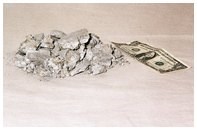Installing A Cleaning Bath Without Shutting Down
Environmentally safe cleaner does not require maintenance shutdown, periodic dumping or solvent replenishment...
On Friday, January 16, 1998, Bradenton, Florida, was deluged with rain. Eight inches of torrential rain engulfed the region in 24 hours. Three of those inches poured during an hour and a half. Many homes and businesses were flooded, including Florida Anodizing & Coloring, Inc. Even though 12 inches of water flooded the entire building, the company was in operation that Monday.
Fortunately, none of the tanks was affected, including the cleaning tank. However, it may not have made much difference if the cleaning tank had overflowed or leaked into the flood waters. Florida Anodizing does not use highly alkaline or acidic cleaners. It uses a biological degreasing system, which is a mild alkaline bath that operates at 115F with a near neutral pH (8.8 to 9.1). This solution replaced an alkaline soak cleaner.
Prior to installing the cleaner, Florida Anodizing noticed that its cleaner efficiency dropped off a couple days after makeup. This would force operators to leave parts in the cleaning tank longer, backing up production and leaving finishing tanks idle. Also, operators would need to constantly add chemicals. Oil and grease would build-up and carry over into the etch and anodizing tanks as well.
The cleaning and etch tanks required dumping every three months. An involved operation, it required five employees to work Saturday to dump and treat the waste and make up a new bath. The total annual cost to dump the etch and cleaner tanks was $12,000. To replenish the tanks cost an additional $4,000; and the labor cost $1,500. Since installing the new bath, the cost for maintenance is less than $1,000 a year, and the life of the etch tank has increased fourfold. Sludge generated from the first six months of operation rendered only one-fourth lb of non-hazardous residue.
Other benefits Florida Anodizing has realized are 50 pct increased throughput and dramatically reduced rejects. Florida Anodizing finishes numerous military parts, boat parts and parts for food preparation systems. Not all parts are anodized. Some are plated with mid-phosphorus electroless nickel from Chemco.
On one particular military part, the company used to run 10 pct rejects. If the finish was poor after etching, the part could not be re-run, since further etching would cause the precise threadings to go out of tolerance standards and ruin the part. The parts used to soak clean for 20 min and go into the etch tank for three min. Now the parts are cleaned in two to three min and etched in 15 sec without rejects.
Another part, a fitting, had to soak overnight to remove oil. The new cleaner removes it in three to seven minutes.
Other parts featured deep recesses that trapped oil. The parts would appear clean and run through the anodizing line. After going through the anodizing dye and sealer steps, oil would leak out, causing the color to run.
Florida Anodizing decided that to increase profits it would have to increase throughput and lower rejects. So it started at the beginning with the cleaner.
The cleaning solution contains nonylphenol-free tensides. When parts enter the solution, tensides lift oil and impurities off the parts and emulsify them into micro particulates that are then consumed by micro organisms in the bath. The bacteria is safe for human contact and is comparable to that used in the food, dairy and brewery industries.
As the volume of oil increases, the organisms multiply in direct proportion, maintaining optimal cleaning power. The micro organisms become more effective as the oils emulsify.
The system is self-contained. It controls solution temperature, pH levels and ten-sides. Automated sensors constantly monitor the solution for Florida Anodizing, adding minute amounts of solutions required to maintain the bath at optimum effectiveness. "The most maintenance I seem to do is dusting off the equipment," quipped Al McNish, finishing supervisor.
Since installing the new cleaning bath approximately a year ago, Florida Anodizing has not had to dump the cleaner. As mentioned, only one-fourth lb of sludge has been generated. Throughput has increased 50 pct, since there is no downtime due to idle tanks. The system has allowed Florida Anodizing to increase business and profits and become more efficient.
Read Next
A ‘Clean’ Agenda Offers Unique Presentations in Chicago
The 2024 Parts Cleaning Conference, co-located with the International Manufacturing Technology Show, includes presentations by several speakers who are new to the conference and topics that have not been covered in past editions of this event.
Read MoreEpisode 45: An Interview with Chandler Mancuso, MacDermid Envio Solutions
Chandler Mancuso, technical director with MacDermid Envio discusses updating your wastewater treatment system and implementing materials recycling solutions to increase efficiencies, control costs and reduce environmental impact.
Read MoreEducation Bringing Cleaning to Machining
Debuting new speakers and cleaning technology content during this half-day workshop co-located with IMTS 2024.
Read More













.jpg;maxWidth=300;quality=90)






